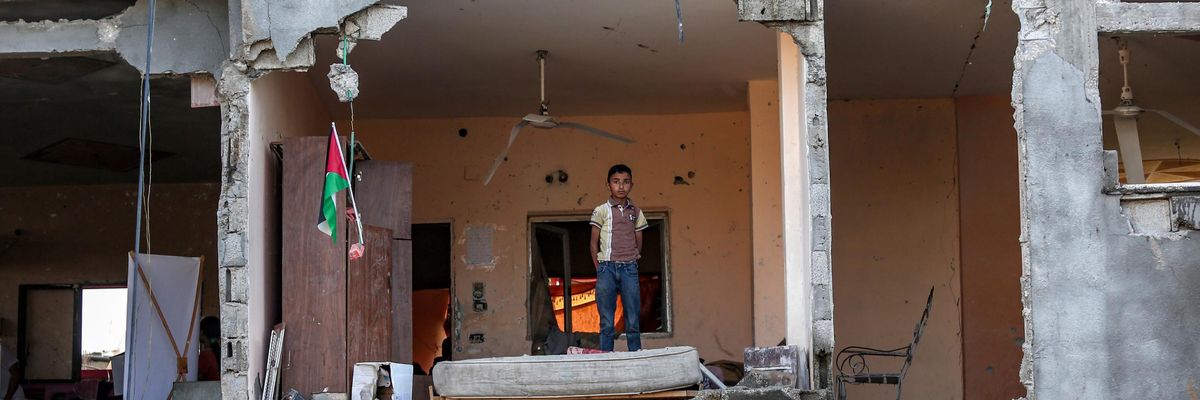Despite repeated claims by both Israel and the United States, there is absolutely no evidence that any of the more than 3,000 Palestinian civilians killed in Israeli military operations against Gaza since 2008 were a result of Hamas using human shields.
Investigations of the most recent round of fighting are still ongoing. But detailed investigations following the 2008-2009 and 2014 conflicts by Human Rights Watch, Amnesty International, the United Nations Human Rights Council, and others have failed to find a single documented case of any civilian deaths caused by Hamas using human shields.
Not one.
Amnesty International, following an extensive investigation after the 2014 war, found no evidence that "Palestinian civilians have been intentionally used by Hamas or Palestinian armed groups during the current hostilities to 'shield' specific locations or military personnel or equipment from Israeli attacks."
By contrast, there were a number of cases during these conflicts where human rights investigators found that advancing Israeli soldiers illegally used Palestinian civilians as human shields.
This did not stop both houses of Congress, by overwhelming bipartisan majorities, from passing resolutions insisting--without evidence--on Hamas's use of human shields while criticizing human rights organizations, reputable international jurists, and other investigators for failing to say they did find such use. Indeed, the resolutions' language was remarkably similar to that put forward by those who defend the Assad regime's attacks on Syrian cities in the name of self-defense against Islamist terrorists.
These investigations documented other war crimes by Hamas, such as its many thousands of indiscriminate rocket attacks into Israel, which have killed dozens of civilians. The investigations also criticized Hamas for not trying to prevent casualties when it positions fighters and armaments too close to concentrations of civilians. However, this is not the same thing as deliberately using civilians as shields, a far more serious offense officially recognized as a crime against humanity.
Unable to find any specific incidents of Hamas using human shields (defined under international law as "Utilizing the presence of a civilian or other protected person to render certain points, areas or military forces immune from military operation"), the U.S. government has therefore attempted to redefine what constitutes human shields.
Following the 2008-2009 conflict, the U.S. House of Representatives passed a resolution calling on the international community to "condemn Hamas for deliberately embedding its fighters, leaders, and weapons in private homes, schools, mosques, hospitals, and otherwise using Palestinian civilians as human shields."
"Unable to find any specific incidents of Hamas using human shields... the U.S. government has therefore attempted to redefine what constitutes human shields."
But the fact that a Hamas leader lives in his own private home, attends a neighborhood mosque, and seeks admittance to a local hospital does not constitute "embedding" for the purpose of "using Palestinians as human shields." Indeed, the majority of leaders of most governments and political parties live in private homes in civilian neighborhoods, go to local houses of worship, and check into hospitals when sick or injured, along with ordinary civilians.
Furthermore, given that the armed wing of Hamas is a militia rather than a standing army, virtually all of its fighters also live in private homes and go to neighborhood mosques and local hospitals.
In short, this resolution--primarily drafted by House Speaker Nancy Pelosi--put both political parties on record advancing a radical and dangerous reinterpretation of international humanitarian law that would allow virtually any country with superior air power or long-range artillery to get away with war crimes.
What neither Republican nor Democratic leaders have acknowledged, however, is that even if a terrorist group was using human shields in the narrower legal definition of the term, it still does not absolve armed forces from their obligation to avoid civilian casualties. Protocol I of the Fourth Geneva Convention makes clear that even if one side is shielding itself behind civilians, such a violation "shall not release the Parties to the conflict from their legal obligations with respect to the civilian population and civilians."
To use a domestic example, if a botched bank robbery resulted in the robbers holding bank personnel and customers hostage and firing at police and passersby from inside the building, it still would not be legitimate for the police to kill the hostages as well because they were being used as "human shields."The implications for U.S. policy are concerning. The House-passed resolution in July 2014, which absolved Israel for responsibility for the large-scale civilian casualties inflicted by its armed forces in Gaza due to the alleged use of human shields by Hamas, also declared (correctly in these cases) that "Al-Qaeda, Al-Shabaab, Islamic State of Iraq and the Levant (ISIL) and other foreign terrorist organizations typically use innocent civilians as human shields."
The inclusion of that clause in the resolution appears to have been designed to justify the massive U.S.-led bombing campaigns, three years later, of the ISIL-held cities of Raqqa in Syria and Mosul in Iraq which resulted in thousands of civilian deaths.
"If an entity that is acting as a de facto government is labeled as a 'terrorist group,' both Washington and Tel Aviv insist, almost any aspect of its operations can become a legitimate target. This means that the Health Ministry, the Education Ministry, the Religious Affairs Ministry, or any other Hamas-run civilian agency and its employees are thereby labeled terrorist assets."
This is part of an ever-expanding set of rules of engagement by U.S. forces that, since the launching of the "war on terror" twenty years ago, effectively dodge the limits on a government's ability to attack civilian targets enshrined in the Geneva Convention. If an entity that is acting as a de facto government is labeled as a "terrorist group," both Washington and Tel Aviv insist, almost any aspect of its operations can become a legitimate target. This means that the Health Ministry, the Education Ministry, the Religious Affairs Ministry, or any other Hamas-run civilian agency and its employees are thereby labeled terrorist assets.
Similarly, the Israeli government has insisted that entire apartment buildings and office complexes can be destroyed if any Hamas officials are alleged to live or work in even a single unit, a rationalization used for the destruction of buildings housing international media, including the Associated Press, during the recent bombing. Israel has been unable to produce any evidence that the office complex that housed the AP and other media outlets also included Hamas military intelligence facilities.
In any case, if indeed Hamas has ever deliberately placed any facilities in such structures, it has clearly never worked, since Israel has time and time again proved itself willing to target civilian structures. Furthermore, it seems rather ludicrous that Hamas would want to house sensitive intelligence operations in a building with a lot of reporters and it is similarly unlikely that media outlets would maintain their offices if Hamas did such a thing, given that the building would become a likely target of Israeli airstrikes.
The tide appears to be turning, however. The outrage at the mounting civilian casualties in last month's conflict--despite being substantially less than in the 2008-2009 and 2014 fighting--led to unprecedented protests. (Indeed, the far deadlier 2017 bombing of Raqqa and Mosul received even less attention, despite being a U.S.-led campaign.)
It was such pressure from the international community and members of Congress that led President Joe Biden, who blocked four otherwise-unanimous U.N. Security Council statements attempting to end the fighting, to finally push the Israeli government to accept a ceasefire.
This was a reminder that U.S. support for attacks on civilian populations can indeed be reversed if popular pressure and enlightened self-interest can be brought to bear.


